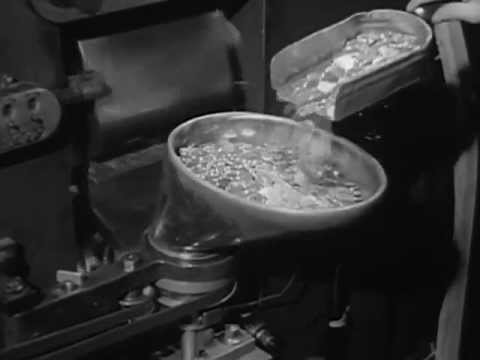more at
Excellent account of the minting of US coins at Philadelphia. Truncated, but the coining process is intact.
‘U.S. Mint scales. engraving, etc.
medals and coin samples
diemaking
die hardening
ingots of metal
melting metal in foundry furnaces
making pigs and rolling sheet metal
planchets being cleaned
pennies being pressed in CU
row of women inspecting coins and smoothing them, removing bad ones
men running counting and bagging machines
montage of coins and money at end, incomplete, ends early’
NEW VERSION with improved video & sound:
Public domain film from the Library of Congress Prelinger Archive, slightly cropped to remove uneven edges, with the aspect ratio corrected, and mild video noise reduction applied.
The soundtrack was also processed with volume normalization, noise reduction, clipping reduction, and equalization (the resulting sound, though not perfect, is far less noisy than the original).
…The third Philadelphia Mint was built at 1700 Spring Garden Street and opened in 1901. It was designed by James Knox Taylor. It was a block from the United States Smelting Company was at Broad and Spring Garden Streets. In one year alone the mint produced 501,000,000 coins (5/7 of the U.S. currency minted) as well as 90,000,000 coins for foreign countries.
A massive structure nearly a full city block, it was an instant landmark. Characterized by a Roman temple facade, visitors enjoyed seven themed glass mosaics designed by Louis C. Tiffany in a gold-backed vaulted ceiling. The mosaics depicted ancient Roman coin making methods. This mint still stands intact with much of the interior as well. It was acquired by the Community College of Philadelphia in 1973…
…In the beginning, hammered coinage or cast coinage were the chief means of coin minting, with resulting production runs numbering as little as the hundreds or thousands. In modern mints, coin dies are manufactured in large numbers and planchets are made into milled coins by the billions.
With the mass production of currency, the production cost is weighed when minting coins. For example, it costs the United States Mint much less than 25 cents to make a quarter, and the difference in production cost and face value (called seigniorage) helps fund the minting body…
Around 1550 the German silversmith Marx Schwab invented coining with the screw press. Henry II of France (reign 1547-1559) imported the new machines: rolling mill, punch and screw press. 8 to 12 men took over from each other every quarter of an hour to maneuver the arms driving the screw which struck the medals. Henry II came up against hostility on the part of the coin makers, so the process was only to be used for coins of small value, medals and tokens. In 1645 it came into general use for minting coins.
Coining by lever press
Between 1817 and 1830 the German engineer Dietrich “Diedrich” Uhlhorn invented the Presse Monétaire (level coin press known as Uhlhorn Press) which bears his name. Uhlhorn invented a new type of minting press (steam driven knuckle-lever press) that made him internationally famous… The advanced construction of the Uhlhorn press proved to be highly satisfactory, and the use of the screw press for general coinage was gradually eliminated…

